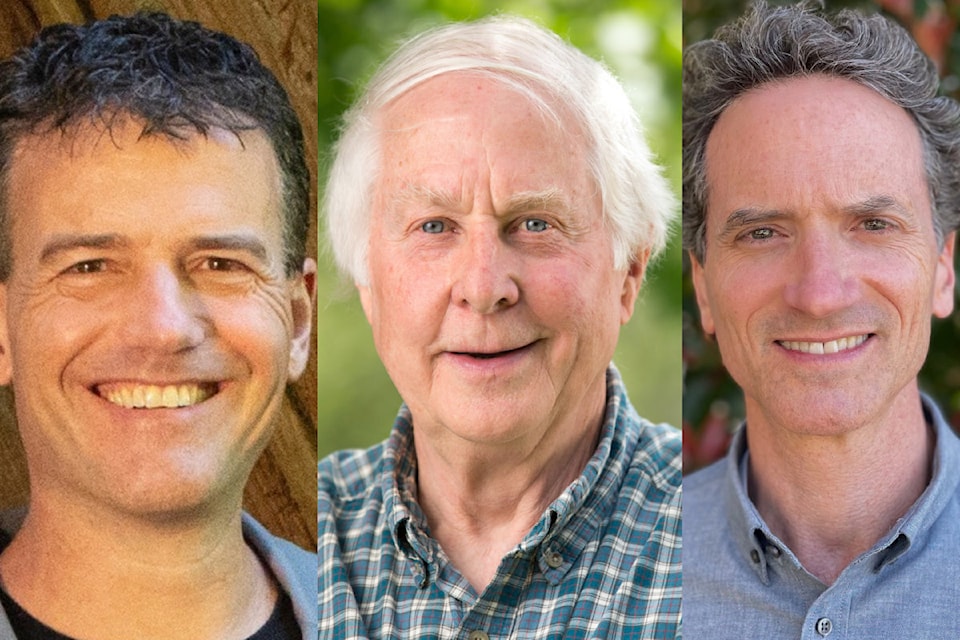Cam Brewer says humans mistakenly believe cities exist independent of nature.
"The idea that we're separate from nature underpins many of the mistakes we've made that have led to ecological catastrophes and human isolation and inequality and problems with cities," says Brewer, an environmental law professor at Simon Fraser University.
"This idea that nature is out there, somewhere else, separate from where we are, was never true and isn't true."
Brewer is a co-author, along with Slocan Valley forest ecologist Herb Hammond and SFU professor of environmental management Sean Markey, of a new book, Nature-First Cities.
The book explores how cities have become ecological wastelands, and it outlines the psychological costs of living with minimal access to natural spaces. It offers strategies for the redesign of urban spaces in ways that integrate nature, proposing solutions beyond traditional greening efforts.
Markey points out that the book is not just a strategy to add more trees and parks.
"We're really trying to up the ante in terms of looking at development that has ecological integrity at its core, and not just a greening strategy," he said during a joint interview with all three authors.
Brewer explained that cities currently pave over whole ecosystems in favour of cars, concrete and sprawl.
"Ecologically, that's a massive cost. Cities get in the way of naturally functioning ecosystems. They interrupt the flow of natural processes."
Paving everything over affects the natural storage, dispersal and cleaning of water, Hammond said.
Rainwater runs off most city surfaces (impermeable concrete and pavement) causing flooding, whereas in a natural setting it would disperse into the ground. To discourage flooding, we could use less concrete and pavement and use permeable versions of those materials that are now available.
"We can change that by getting rid of impermeable surfaces," he said, "or reducing them drastically, and developing natural multi-layered vegetation in cities that disperse water and cool the city."
Lack of layered greenery results in the creation of "heat islands" from re-emission of the sun's rays by concrete and glass.
Hammond said engineers have warned that cities, because of climate change, will have to double their storm sewer capacity at a cost of millions of dollars.
In cities built for cars, people spend much of their time in them and are otherwise disconnected from nature, seasons and natural cycles.
Brewer said one of the book's goals is to "heal the human dislocation, the human isolation that is a symptom of separation from nature and separation from each other."
He said the book "documents quite thoroughly all the psychological and physiological costs of not having nature in their lives."
The authors said the book marries these ideas with the need for density, which is important for addressing climate change. Both nature and density have to happen equally across the city, they said.
Markey suggested some possible starting points: save green space that is not already paved over; apply different development standards to sensitive ecological areas; when improving or adding infrastructure, build it differently to better adapt to climate change; and restore natural water movement networks.
"This can involve really, really long timelines," he said.
Hammond said development needs to look at the ecosystems that existed before the city was built, and restore or preserve them as much as possible. He calls this "nature-directed stewardship."
"We need to move back towards the natural character of the areas where cities were built," Herb Hammond says in a new book. "This provided not only biodiversity and ecological Integrity, but also a very healthy environment."
He gave the example of the Still Creek watershed, one of the few remaining visible streams in Vancouver. An ongoing restoration project at the creek conducted by Hammond's Silva Forest Foundation provides habitat and drainage by collecting and funnelling rainwater, restoring creek-side habitat to include native plants while removing invasive species, increasing canopy cover and vegetation for urban wildlife, removing old concrete features, naturalizing the creek banks, and uncovering buried portions of the creek.
He also worked with the Shawnigan Basin Society near Victoria to protect and restore water in a forested landscape. The community made a plan and the regional district then put it into development requirements.
"And while that isn't as strong as as legal protection, it's going a long ways in that direction."
Hammond said the interests of neighbourhoods are often different from those of developers, who might not care about restoration of ecosystems but do have lobbying power with municipal governments.
The book recommends that successful returns to nature in cities need to originate in neighbourhoods.
"It starts with individuals and neighbourhoods," Brewer said. "So if someone has access to a backyard or a bit of space at their work or in some other way, maybe at their community gathering space in which they can say, 'Let's figure out what the character is in this place and try to restore it.'"
But then they need local governments, and perhaps higher levels of government, to get involved at some point — not to drive the process but enable it to expand. The book lays out strategies and recommendations on how to encourage this.
Brewer said cities are built in particular places because those places are "ecologically attractive ... and yet that attractiveness of the particular place is often obliterated by pavement and shopping malls and generic nature, grass."
He hopes the book will empower people to reconnect to where they live.
"I don't think it can be understated, because it gives people a real excitement about doing this restoration work because in the place where they live, there is a sense of pride and place."



